How to Count Many Bones in Sparrow Wings
A sparrow's wings are composed of several vital bones that facilitate its adept flying capabilities. The key bones include the humerus, radius, ulna, and a series of carpal and phalangeal bones.
The humerus connects major flight muscles, aiding in lift. The radius and ulna work together to provide structural integrity and flexibility.
The carpometacarpus supports primary feathers essential for thrust and maneuverability. Additionally, phalanges at the wing tips aid in fine adjustments during flight.
This intricate bony framework, combined with precise muscle control, enables sparrows' remarkable agility. To understand the complete anatomical and functional dynamics, consider exploring further.
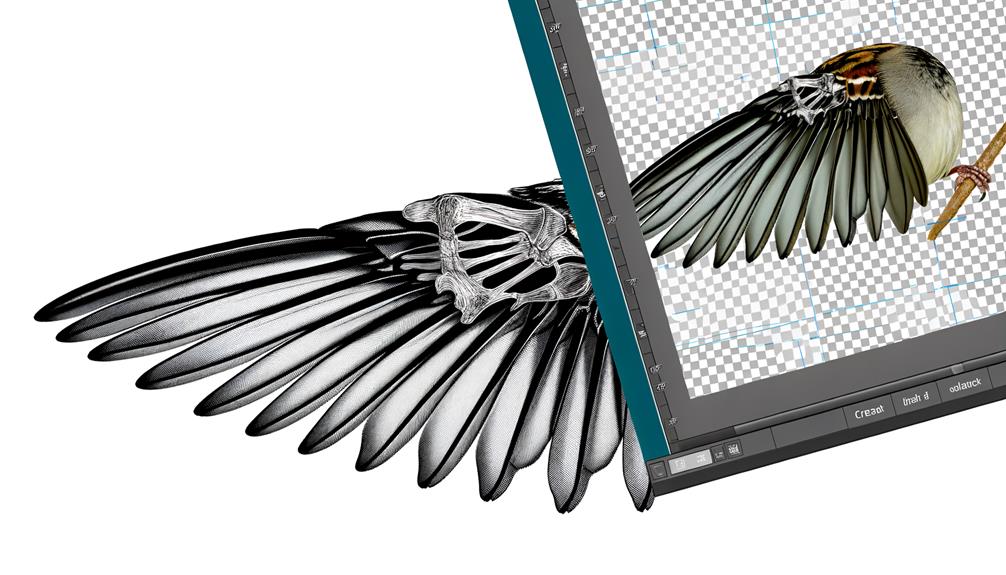
Key Takeaways
- Sparrows have a humerus, radius, ulna, and carpometacarpus in each wing.
- Each wing contains phalanges, essential for manipulating wingtip feathers.
- The wing bones are lightweight and hollow for efficient flight.
- Joints between bones provide flexibility and range of motion.
- The carpometacarpus is a fused structure supporting primary feathers.
Sparrow Wing Anatomy
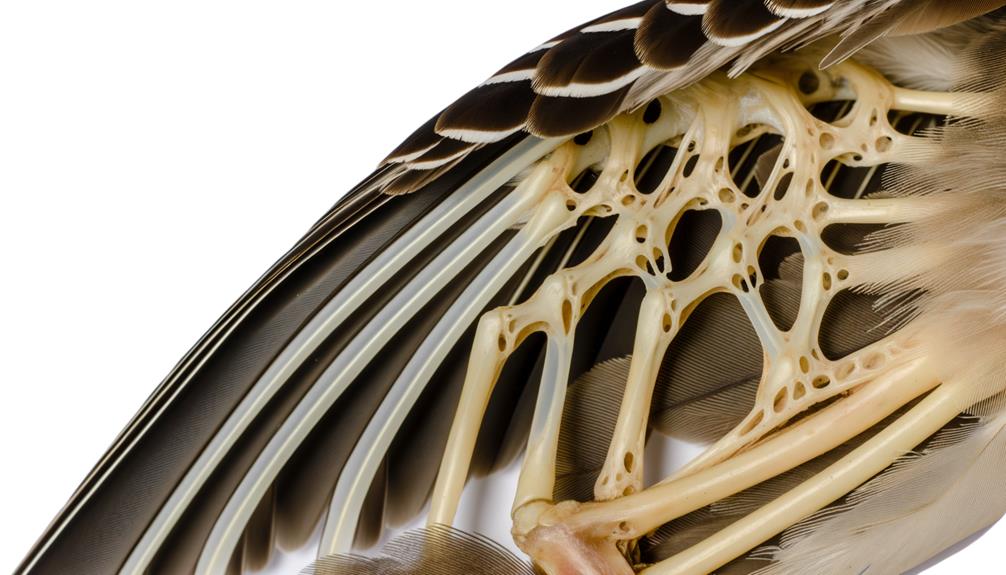
The anatomy of a sparrow's wing is a complex structure composed of various bones, muscles, tendons, and feathers that enable flight. The primary skeletal components include the ulna, radius, and carpal bones, which form the wing's framework. These bones are connected by joints that provide both rigidity and flexibility, essential for various flight maneuvers.
Muscles such as the pectoralis major and supracoracoideus generate the powerful downstroke and controlled upstroke, respectively. Tendons interlink these muscles to the bones, transmitting force efficiently.
Feathers, categorized into primary, secondary, and coverts, streamline the wing and assist in lift and thrust. This intricate assembly allows sparrows to perform agile flights, rapid directional changes, and sustained gliding, showcasing evolutionary optimization for aerial mobility.
The Humerus
Situated proximally within the sparrow's wing, the humerus serves as the primary bone connecting the shoulder to the elbow, playing a critical role in flight mechanics.
This bone is relatively short and robust, designed to withstand the considerable forces generated during flight.
The proximal end of the humerus articulates with the scapula at the glenoid cavity, forming a ball-and-socket joint that permits a wide range of motion.
Distally, the humerus articulates with both the radius and ulna, facilitating the wing's complex movements.
The humerus also serves as an attachment point for powerful flight muscles, including the pectoralis major and supracoracoideus, which are essential for the downstroke and upstroke of the wing, respectively.
The Radius

The radius in a sparrow's wing plays an essential role in both the structural integrity and the aerodynamic functionality of the wing. This bone's morphology and articulation with the ulna allow for the necessary flexibility and strength required for flight.
Comparative anatomy reveals significant evolutionary adaptations in the radius that enhance flight efficiency across different bird species.
Structure and Function
Integral to the sparrow's wing structure, the radius is a slender bone that plays a critical role in enabling flight mechanics. Located parallel to the ulna, the radius supports the wing's aerodynamic shape and facilitates the articulation of primary flight feathers.
This bone's lightweight yet sturdy composition allows for the necessary flexibility and strength during wing beats. Its proximal end articulates with the humerus at the elbow joint, while the distal end connects to the carpal bones, ensuring smooth transmission of muscular forces.
The radius's precise curvature and length are pivotal in maintaining the wing's structural integrity, optimizing both lift and thrust. Consequently, the radius is essential for the sparrow's intricate flight dynamics, contributing significantly to its agility and maneuverability.
Comparative Anatomy
When examining the radius across different avian species, one notices significant variations in morphology that correlate with diverse flight patterns and ecological niches. The radius, an essential bone in the avian wing, demonstrates adaptation to various functional demands.
For instance, in sparrows, the radius is relatively short and robust, supporting fast, nimble flight essential for maneuvering dense foliage.
In contrast, albatrosses possess a more elongated radius, facilitating their soaring capabilities over vast oceanic expanses.
Additionally, woodpeckers exhibit a radius adapted for stability and precision during vertical climbing and percussive actions.
These morphological differences underscore the intricate relationship between form and function in avian wings.
Evolutionary Significance
Understanding the evolutionary significance of the radius in avian species necessitates a thorough examination of its morphological adaptations in relation to diverse ecological roles and flight mechanics.
The radius, one of the primary bones in a bird's wing, plays an essential role in enabling complex wing movements and efficient energy use during flight. Its streamlined shape and lightweight nature are results of evolutionary pressures favoring enhanced aerodynamic efficiency.
Comparative studies reveal that variations in radius length and robustness correlate with different flight styles, such as soaring, flapping, or hovering. In sparrows, the radius has evolved to support rapid, agile flight, essential for foraging and predator evasion in dense habitats.
This underscores the adaptive significance of the radius in avian evolutionary success.
The Ulna
The ulna, one of the two long bones found in the forearm of a sparrow, plays a significant role in the bird's ability to fly by providing structural support and facilitating the attachment of flight feathers. This bone, positioned parallel to the radius, secures the wing's integrity and functionality.
Key functions of the ulna include:
- Attachment Site: Anchors primary flight feathers, essential for lift and maneuverability.
- Structural Support: Maintains wing shape during various stages of flight.
- Muscle Attachment: Serves as a site for muscles that control wing movements.
The ulna's robust structure is vital for sustaining the aerodynamic forces experienced during flight, highlighting its evolutionary adaptation for efficient avian locomotion. Consequently, its anatomy directly influences a sparrow's flight performance.
The Carpals
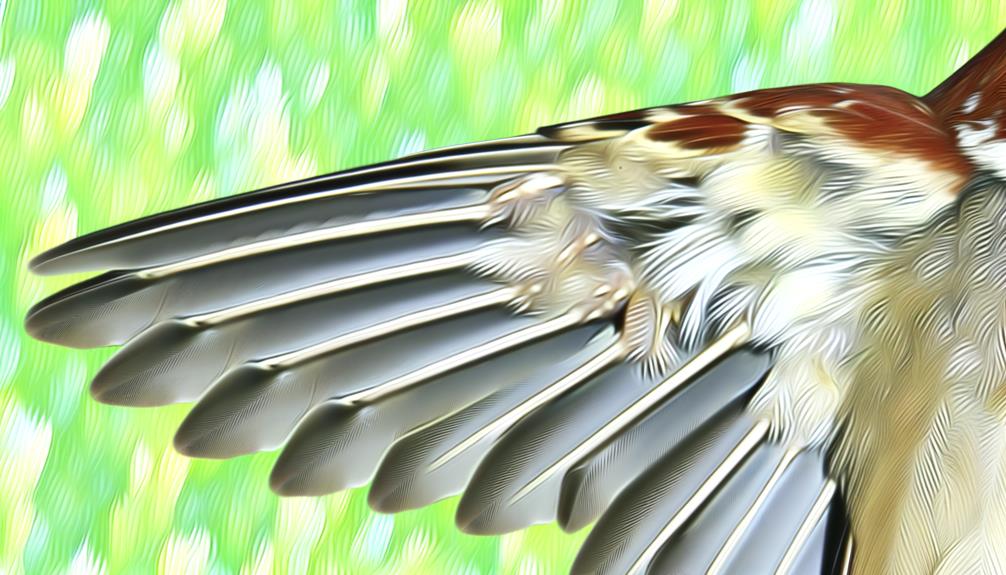
The carpals in a sparrow's wings are comprised of a small set of bones that play an important role in wing articulation and flight dynamics. These bones enable significant joint flexibility, allowing for the intricate movements necessary for flight maneuvers.
Significantly, the sparrow's carpal bone count is reduced compared to other vertebrates, a characteristic that contributes to its lightweight skeletal structure.
Sparrow Carpal Structure
In sparrows, the carpal bones play a vital role in the mechanics of wing movement and overall flight dynamics. The carpus comprises two primary bones: the radiale and the ulnare. These bones facilitate the intricate movements necessary for flight and provide structural support to the wing.
Key aspects of sparrow carpal structure include:
- Radiale: Positioned near the radius, it aids in the articulation of the wing.
- Ulnare: Located adjacent to the ulna, it contributes to the wing's flexibility and strength.
- Intercarpal Ligaments: These connective tissues maintain the stability of the carpal bones, ensuring coordinated wing movements.
Understanding the carpal structure is essential for comprehending how sparrows achieve their remarkable aerial agility.
Carpal Joint Flexibility
Having established the structural foundation of the carpal bones, attention must now be directed towards the remarkable flexibility of the carpal joints, which enables sparrows to execute complex and rapid wing movements essential for flight agility.
This flexibility is primarily facilitated by the unique arrangement and articulation of the carpal bones, allowing a wide range of motion. The carpal joints in sparrows possess highly specialized ligaments and tendons, which provide both stability and elasticity. These anatomical features permit swift adjustments in wing positioning, essential for maneuvers such as hovering, rapid take-offs, and intricate aerial acrobatics.
Additionally, the synovial fluid within these joints reduces friction, enabling smoother, more efficient movements that contribute to the sparrow's extraordinary flight endurance and precision.
Carpal Bone Count
Understanding the exact number and arrangement of carpal bones in sparrows is vital for comprehending the biomechanical underpinnings of their flight capabilities. In avian anatomy, the carpal region plays a pivotal role in wing movement and flexibility. Sparrows, like most birds, typically possess two primary carpal bones: the radiale and the ulnare. These bones facilitate the articulation between the wing and the forearm, contributing significantly to their aerodynamic efficiency.
Key features of sparrow carpal bones include:
- Radiale: Supports the proximal carpal joint, connecting with the radius.
- Ulnare: Assists in the distal carpal joint, interfacing with the ulna.
- Functional Adaptation: These bones are adapted for lightweight and strength, vital for sustained flight.
Understanding these aspects underscores the intricate design of avian flight mechanics.
The Metacarpals
The metacarpals in a sparrow's wing are an essential component of its skeletal structure, providing both support and flexibility necessary for flight. These bones are elongated and fused to form a rigid yet adaptable framework. This structural adaptation allows for efficient force transmission during wing beats, enhancing aerodynamic efficiency.
Sparrows possess three primary metacarpal bones, which are intricately connected to the carpal bones proximally and the phalanges distally. This configuration is critical for maintaining wing shape and function. The fusion of these bones reduces weight while increasing strength, thereby optimizing the bird's ability to maneuver through various flight patterns.
Understanding the role of metacarpals provides insight into the biomechanical prowess of avian flight.
The Phalanges
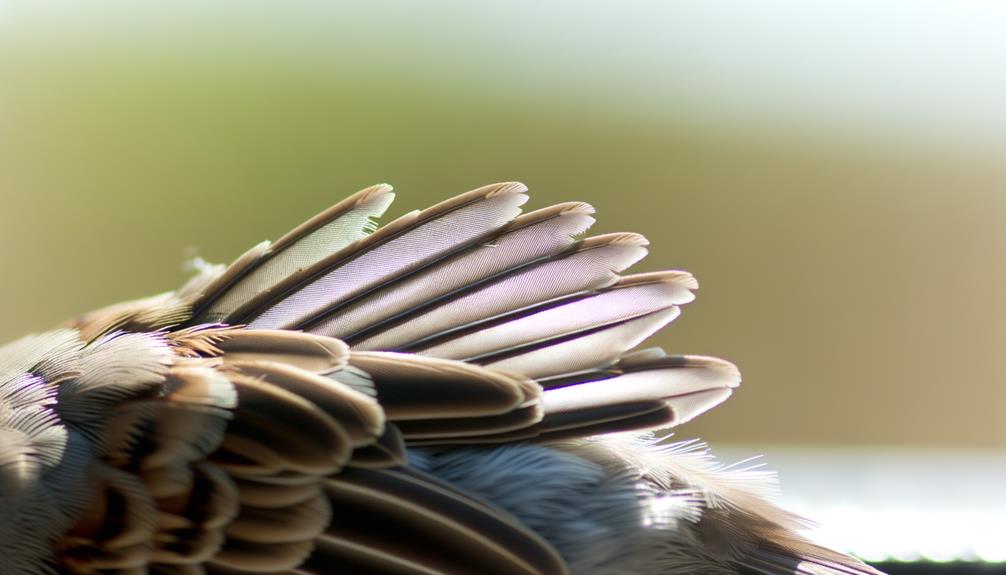
Phalanges, the distal bones in a sparrow's wing, play a pivotal role in the articulation and dexterity of the bird's flight mechanisms. These bones are intricately designed to facilitate various flight maneuvers and are essential for fine-tuned wing movements.
The phalanges in a sparrow's wings can be categorized into three distinct types:
- Proximal Phalanges: Closest to the body, these bones provide foundational support.
- Intermediate Phalanges: These bones contribute to the flexibility and range of motion.
- Distal Phalanges: Positioned at the tips, they aid in precise control during flight.
Understanding the structure and function of these phalanges offers insight into the complex biomechanics of avian flight, emphasizing their importance in the overall anatomy of sparrow wings.
Joint Functions
Joint functions play a critical role in the biomechanics of a sparrow's wings, enabling coordinated and efficient flight movements through precise articulation and control.
The primary joints in a sparrow's wings include the shoulder (scapulohumeral) joint, the elbow (humeroradioulnar) joint, and the wrist (carpometacarpal) joint. These joints facilitate a range of motions essential for various flight maneuvers, such as flapping, gliding, and hovering.
The shoulder joint allows for the up-and-down motion of the wing, while the elbow joint contributes to wing folding and extension. The wrist joint aids in fine-tuning wing shape during flight.
The synovial structure of these joints provides lubrication, minimizing friction and wear, thereby ensuring longevity and functional efficiency.
Bone Structure
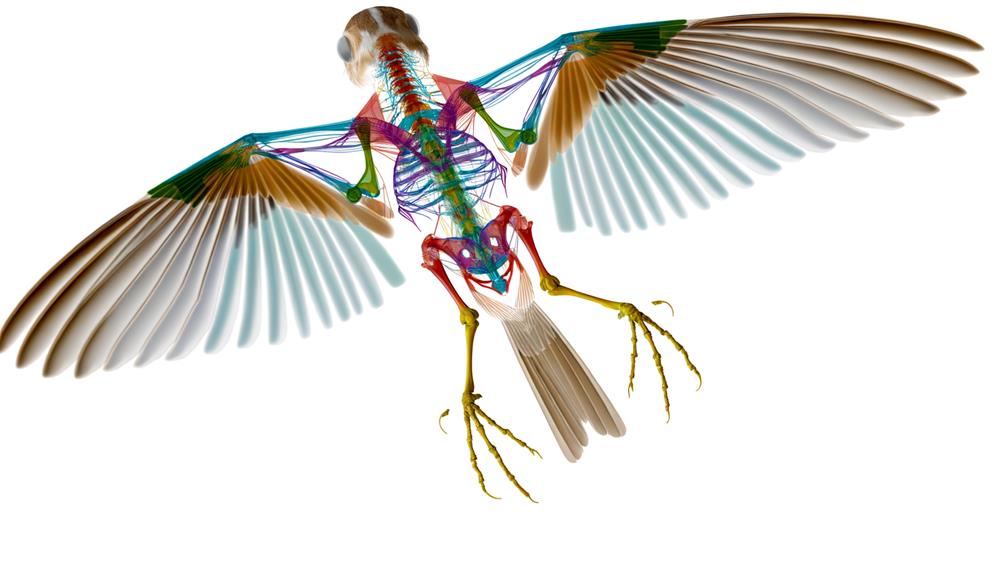
The bone structure of a sparrow's wings comprises specialized elements such as the humerus, radius, and ulna, which are adapted for flight.
These bones are lightweight yet robust, providing both strength and flexibility essential for sustained airborne activity.
Each bone plays an essential role in wing functionality, facilitating complex movements and enabling aerodynamic efficiency.
Wing Bone Anatomy
Sparrow wing bone anatomy comprises several important structures that contribute to the bird's flight capabilities. The humerus is the proximal bone that articulates with the scapula, enabling wing rotation. The radius and ulna, positioned parallel to each other, form the forearm, essential for wing extension and flexion.
The carpometacarpus, a fusion of carpal and metacarpal bones, provides structural integrity and support for the primary feathers. Finally, the phalanges are the terminal bones that are essential for feather attachment and maneuverability.
The humerus aids in wing rotation, while the radius and ulna are crucial for wing movements. The carpometacarpus supports primary feathers, ensuring structural integrity.
Key Bone Functions
Understanding the specific functions of each bone within a sparrow's wing reveals how their precise anatomical structure supports various aspects of flight performance and maneuverability.
The humerus, forming the upper wing, serves as the primary attachment for powerful flight muscles, enabling lift and propulsion.
The radius and ulna, running parallel in the middle wing segment, provide structural integrity and flexibility, allowing for wing extension and retraction.
The carpometacarpus, a fusion of carpal and metacarpal bones, supports the primary feathers essential for thrust and control.
Additionally, the phalanges, or finger bones, manipulate the wingtip feathers, enhancing fine motor adjustments during flight.
Collectively, these bones facilitate agile, energy-efficient flight, essential for the sparrow's survival and ecological niche.
Wing Flexibility
Wing flexibility in sparrows is primarily facilitated by the intricate arrangement and articulation of several specialized bones, including the humerus, radius, and ulna. These bones work together to provide the necessary range of motion for various wing movements.
The humerus acts as the primary support, connecting the shoulder to the mid-wing. The radius and ulna, positioned parallel to each other, enable delicate adjustments during flight.
Key aspects contributing to wing flexibility include:
- Joint articulation: The ball-and-socket shoulder joint allows multi-directional movement.
- Bone structure: Lightweight and hollow, bones reduce the load while maintaining strength.
- Feather attachment: Feathers connect to specific points, aiding aerodynamic efficiency.
This sophisticated bone structure ensures optimal wing flexibility, essential for the sparrow's agile flight.
Flight Mechanics

Effective flight mechanics in sparrows involve the coordinated interaction of muscular, skeletal, and aerodynamic elements to achieve controlled and efficient movement through the air.
The primary muscles responsible for flight are the pectoralis and supracoracoideus, which facilitate wing flapping and elevation. The skeletal structure includes the humerus, radius, and ulna, forming a rigid yet flexible framework that supports flight.
Aerodynamically, sparrows utilize their wing shape, featuring a cambered profile, to generate lift and reduce drag.
The rapid, synchronized contraction of flight muscles guarantees precise control over wingbeat frequency and amplitude. This intricate interplay allows sparrows to execute complex maneuvers, such as rapid ascents, tight turns, and swift descents, essential for their survival and ecological roles.
Comparative Anatomy
In comparing the anatomical structures of sparrow wings to those of other avian species, distinct variations in bone morphology and muscle attachment points reveal significant evolutionary adaptations tailored to their unique flight behaviors. Sparrows, for instance, possess relatively shorter and more rounded wings, which facilitate quick, agile maneuvers essential for their survival in dense vegetation.
Their wing anatomy includes:
- Humerus: Robust and compact, optimizing for rapid wingbeats.
- Radius and Ulna: Shortened yet sturdy, contributing to stability during flight.
- Carpometacarpus: Fused bones leading to a strengthened wing tip, essential for precision in flight control.
These variations underscore the intricate relationship between form and function, enhancing our understanding of avian flight dynamics and evolutionary biology.
Conclusion
In the intricate dance of avian flight, the sparrow's wing serves as a masterful symphony of bones—humerus, radius, ulna, and carpals—each playing a precise role.
Much like the delicate gears of a finely-tuned clock, these bones confer both structure and flexibility, enabling the sparrow's aerial ballet.
The seamless interplay of these elements mirrors the harmony required in complex systems, where every component, no matter how small, contributes to the overall elegance and functionality of the whole.






